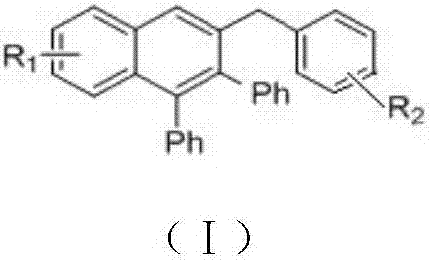Method for preparing polyaryl substituted naphthalene derivative by ruthenium-catalyzing aromatic ketone and diphenylacetylene cyclization reaction and application
A technology of naphthalene derivatives and tolanylacetylene, which is applied in the field of preparation of polyaromatic substituted naphthalene derivatives, can solve problems such as increasing production costs, and achieve the effect of simple and easy synthesis method
- Summary
- Abstract
- Description
- Claims
- Application Information
AI Technical Summary
Problems solved by technology
Method used
Image
Examples
Embodiment 1
[0019]
[0020] To a 25mL sealed tube with a magnet, add toluene (18mg, 0.1mmol), the corresponding aromatic ketone (0.2mmol), catalyst [RuCl 2 (p-cymene)] 2 (9mg, 15% mol), 0.5mL toluene, then add dry sodium carbonate (21mg, 0.2mmol) and potassium acetate (19mg, 0.2mmol), replace nitrogen three times, react at 100°C for 24 hours, then pass column chromatography Separation (eluent: petroleum ether) to obtain the target compound. Characterization is as follows.
[0021] 7-Methyl-3-(4-methylbenzyl)-1,2-diphenylnaphthalene: yield: 58%, melting point: 124-125°C. 1 H NMR (CDCl 3 ,400MHz)δ7.71(d,J=8.0Hz,1H),7.61(s,1H),7.28(dd,J 1 = 1.2Hz; J 2 =8.4Hz,1H),7.14-7.23(m,4H),7.05-7.10(m,5H),7.00(d,J=8.0Hz,2H),6.90-6.93(m,2H),6.85(d, J=7.6Hz,2H),3.86(s,2H),2.35(s,3H),2.29(s,3H). 13 C NMR (CDCl 3 ,100MHz)δ140.2,139.9,139.6,138.4,137.9,136.7,135.2,135.2,131.6,131.1,130.5,129.1,128.8,128.0,127.6,127.4,127.4,127.3,126.1,2,125.2,125.6 .HRMS(EI-TOF)calcd for C 31 h 26 (M + ):398.2...
Embodiment 2
[0023]
[0024] To a 25mL sealed tube with a magnet, add toluene (18mg, 0.1mmol), the corresponding aromatic ketone (0.2mmol), catalyst [RuCl 2 (p-cymene)] 2 (9mg, 15% mol), 0.5mL toluene, then add dry sodium carbonate (21mg, 0.2mmol) and potassium acetate (19mg, 0.2mmol), replace nitrogen three times, react at 100°C for 24 hours, then pass column chromatography Separation (eluent: petroleum ether) to obtain the target compound. Characterization is as follows.
[0025] 7-Methoxy-3-(4-methoxybenzyl)-1,2-diphenylnaphthalene: yield: 45%, melting point: 137-139°C. 1 HNMR (CDCl 3 ,400MHz)δ7.72(d,J=8.8Hz,1H),7.59(s,1H),7.16-7.18(m,2H),7.07-7.14(m,7H),6.90-6.92(m,2H) ,6.86(d,J=8.8Hz,2H),6.76(d,J=2.8Hz,1H),6.72-6.74(m,2H),3.83(s,2H),3.76(s,3H),3.64( s,3H). 13 C NMR (CDCl 3 ,100MHz)δ157.7,157.4,140.2,139.6,138.1,135.5,133.2,132.5,130.9,130.4,130.1,129.1,128.4,127.5,127.3,126.3,126.1,118.55,113.5,105.3MS (EI-TOF) calcd for C 31 h 26 o 2 (M + ):430.1933,found:430.1937.
Embodiment 3
[0027]
[0028] To a 25mL sealed tube with a magnet, add toluene (18mg, 0.1mmol), the corresponding aromatic ketone (0.2mmol), catalyst [RuCl 2 (p-cymene)] 2 (9mg, 15% mol), 0.5mL toluene, then add dry sodium carbonate (21mg, 0.2mmol) and potassium acetate (19mg, 0.2mmol), replace nitrogen three times, react at 100°C for 24 hours, then pass column chromatography Separation (eluent: petroleum ether) to obtain the target compound. Characterization is as follows.
[0029] 7-Fluoro-3-(4-fluorobenzyl)-1,2-diphenylnaphthalene: yield: 60%, melting point: 107-108°C. 1 H NMR (CDCl 3 ,400MHz)δ7.81(dd,J 1 = 5.6Hz; J 2 =9.2Hz,1H),7.65(s,1H),7.15-7.25(m,4H),7.04-7.10(m,6H),6.85-6.88(m,6H),3.89(s,2H). 13C NMR (CDCl 3 ,100MHz)δ162.5,161.9,160.1,159.5,140.6,139.6,138.9(d,J C-F =5.6Hz), 138.8, 136.6(d, J C-F =3.3Hz), 136.3(d, J C-F =4.3Hz), 132.5(d, J C-F =7.6Hz), 130.8, 130.4(d, J C-F =7.2Hz), 130.3, 129.9, 129.8, 127.7 (d, J C-F =6.4Hz), 127.4, 126.7, 126.4, 116.4, 116.1, 115...
PUM
 Login to View More
Login to View More Abstract
Description
Claims
Application Information
 Login to View More
Login to View More - R&D
- Intellectual Property
- Life Sciences
- Materials
- Tech Scout
- Unparalleled Data Quality
- Higher Quality Content
- 60% Fewer Hallucinations
Browse by: Latest US Patents, China's latest patents, Technical Efficacy Thesaurus, Application Domain, Technology Topic, Popular Technical Reports.
© 2025 PatSnap. All rights reserved.Legal|Privacy policy|Modern Slavery Act Transparency Statement|Sitemap|About US| Contact US: help@patsnap.com



